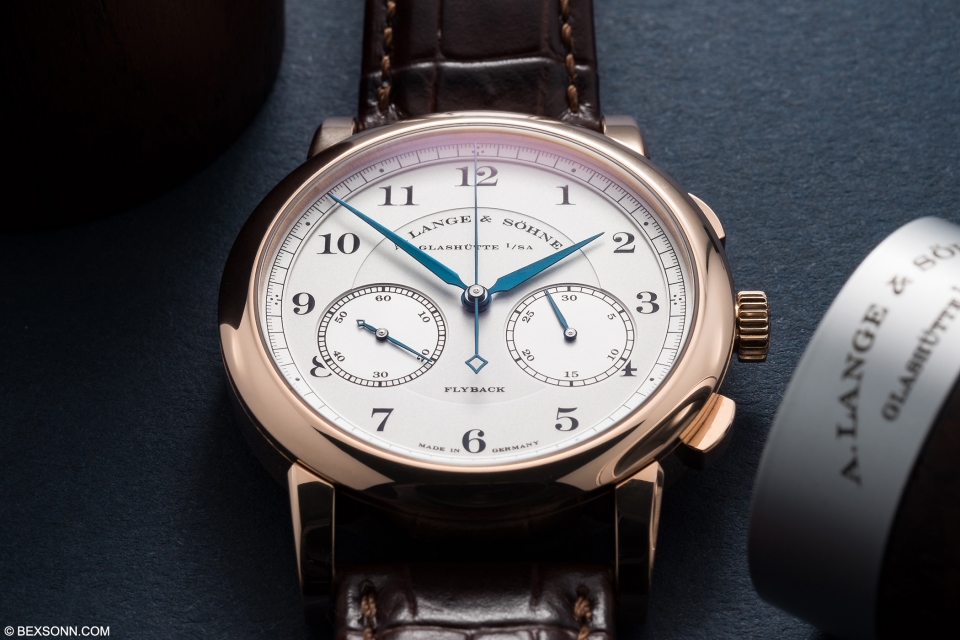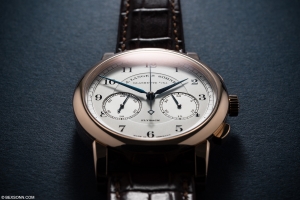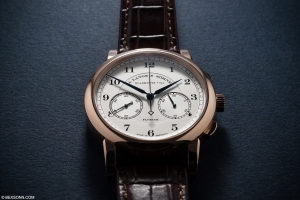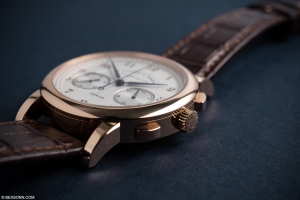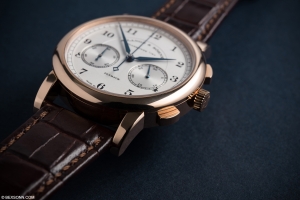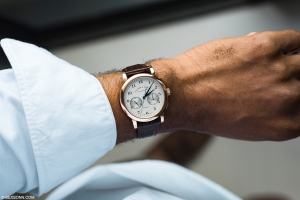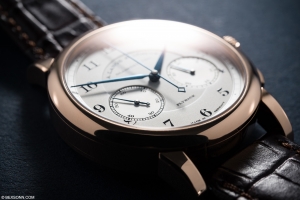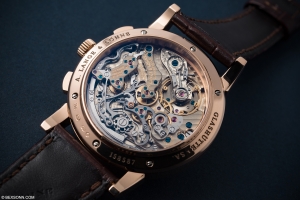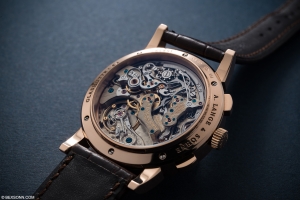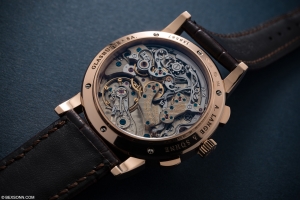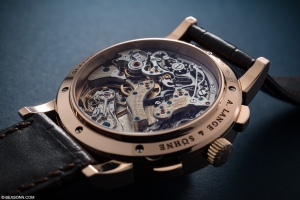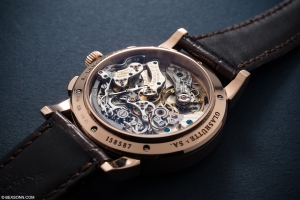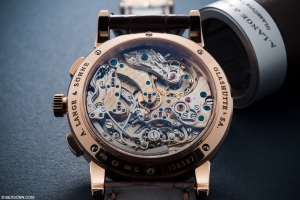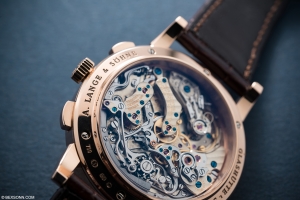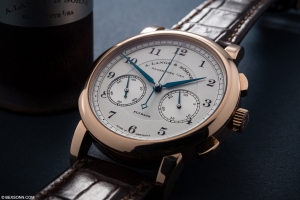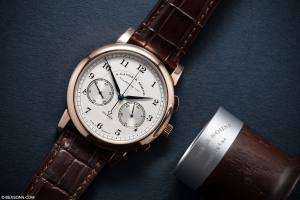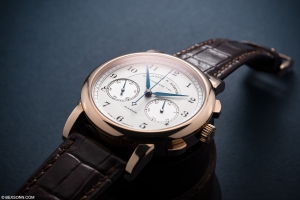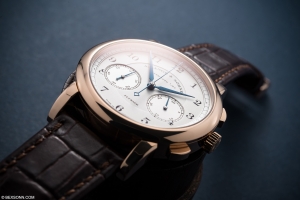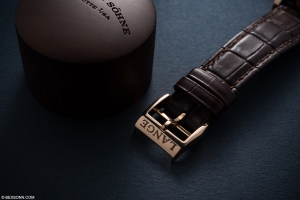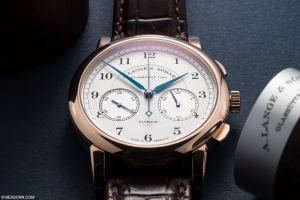Not too long ago, I had the pleasure of wearing this beautiful chronograph and sure enough, even after a few hours of wrist time I was smitten. While there are loads more useful complications on today’s watch market to choose from, still I find myself drawn to the allure of the chronograph. Why? It’s hard to say, as in this day in age they are seldom useful but there are odd moments where I find myself actually using its purposeful function. If you are a regular visitor here, then you’ll know by now the love and appreciation I have for chronographs and even more so, traditional column chronographs but one of the pieces that always intrigues me is the flyback. If you haven’t already you can read my exhaustive piece, I wrote last year on the Lange Double-Split Flyback and a brief bit of history on the chronograph itself.
It was way back in 1999 that Lange stunned the world of watchmaking with their Datograph and the thing is, not only was it a fully in-house developed chronograph, (which I may add not many attempt to develop in their adolescent years), but it also featured a flyback function. And to add to this, a big date window and power reserve indicator. The 1815 chronograph is essentially a Datograph but of course the obvious is the omission of the large date window and power reserve, which admittedly affords for a much cleaner dial.
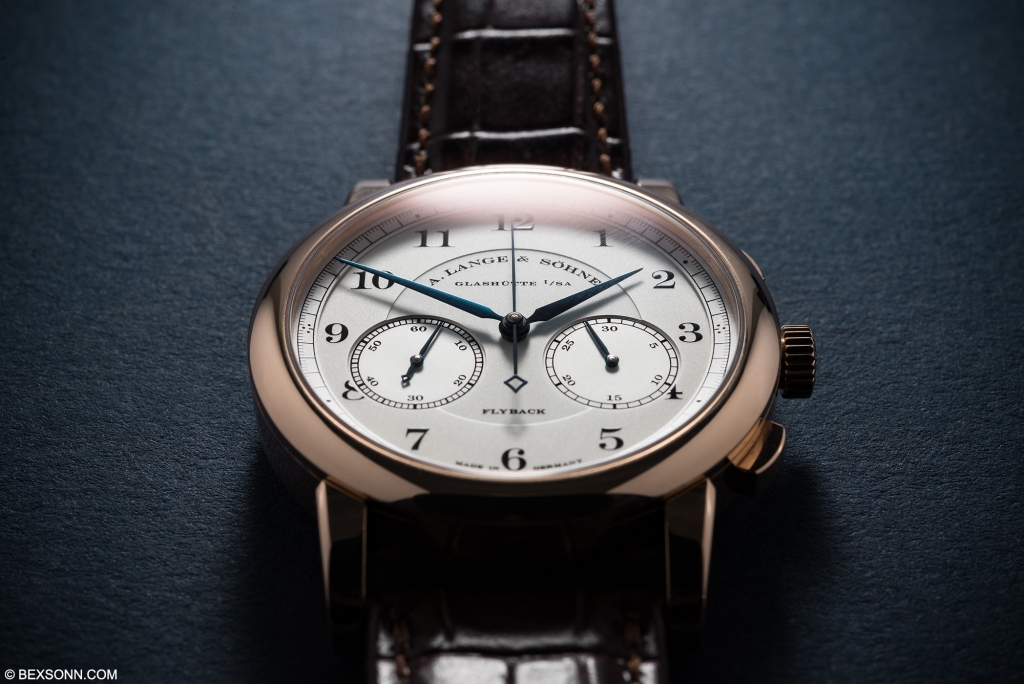 The 1815 Flyback was originally launched in 2004, it garnered quite a bit of attention, despite the fact this was also the same year the DS Flyback was released too. While it didn’t create the hysteria that surrounded the Datograph, what Lange offered was the same great chronograph movement that could be found in the Datograph, in a smaller package, with purer chronograph aesthetics and a more wearable case design. With the omission of the big date, this afforded a much smaller movement, which Lange housed in a case that only measured a mere 10.8 mm thick in comparison to the 13.1 mm of the Datograph. The first 1815 Flyback actually featured a black dial with white subsidiary dials and a pulse-o-metre scale, which in my opinion looked pretty darn cool and was perhaps more nostalgic of early 20th century chronographs.
The 1815 Flyback was originally launched in 2004, it garnered quite a bit of attention, despite the fact this was also the same year the DS Flyback was released too. While it didn’t create the hysteria that surrounded the Datograph, what Lange offered was the same great chronograph movement that could be found in the Datograph, in a smaller package, with purer chronograph aesthetics and a more wearable case design. With the omission of the big date, this afforded a much smaller movement, which Lange housed in a case that only measured a mere 10.8 mm thick in comparison to the 13.1 mm of the Datograph. The first 1815 Flyback actually featured a black dial with white subsidiary dials and a pulse-o-metre scale, which in my opinion looked pretty darn cool and was perhaps more nostalgic of early 20th century chronographs.
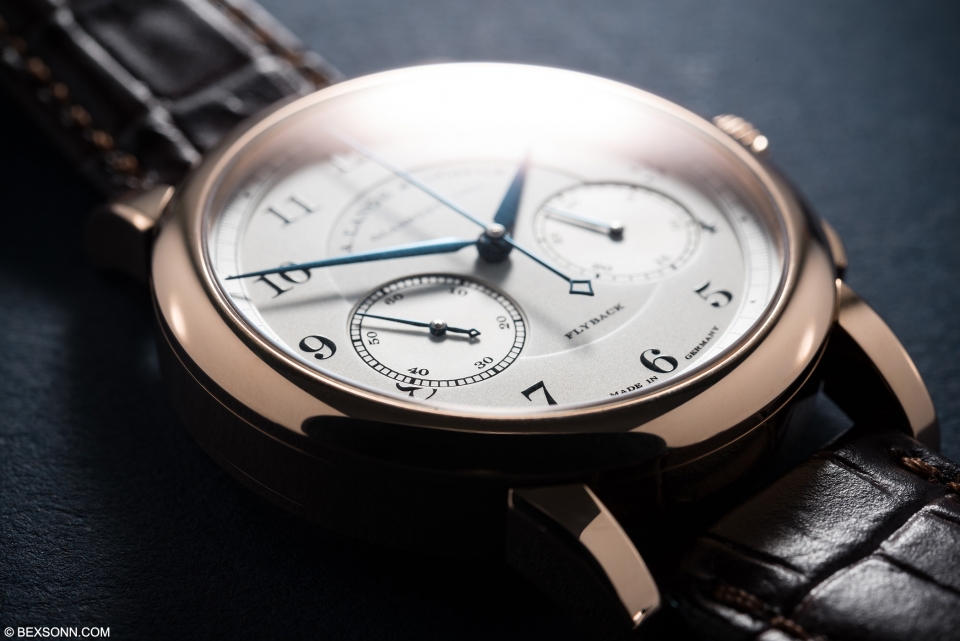 This newer 1815 Flyback Chronograph was first introduced in 2010 and makes no use of any scales whatsoever, which makes for a cleaner look but does take away some of the charm earlier models possessed. The dial is a mono-tone affair of silver argenté, with black accents marking the sub dials, hours and minute track. The outer railroad minute track that has been placed on a slight inclined flange, makes use of a 1/5th-minute inner scale, with strategically placed dots marking the hours, with each quarter-hour marked with 3 dots, resembling a club. The dial features full Arabic numerals for hours and two engine-turned subsidiary dials, which are ever so slightly sunken level from the main dial, recording chronograph minutes and continuous seconds. Again, both make use of railroad track scales, which adds a certain sense grandeur. While face on the dial may appear flat, the subtle levels on which each aspect of the dial is placed, lends some much-needed depth.
This newer 1815 Flyback Chronograph was first introduced in 2010 and makes no use of any scales whatsoever, which makes for a cleaner look but does take away some of the charm earlier models possessed. The dial is a mono-tone affair of silver argenté, with black accents marking the sub dials, hours and minute track. The outer railroad minute track that has been placed on a slight inclined flange, makes use of a 1/5th-minute inner scale, with strategically placed dots marking the hours, with each quarter-hour marked with 3 dots, resembling a club. The dial features full Arabic numerals for hours and two engine-turned subsidiary dials, which are ever so slightly sunken level from the main dial, recording chronograph minutes and continuous seconds. Again, both make use of railroad track scales, which adds a certain sense grandeur. While face on the dial may appear flat, the subtle levels on which each aspect of the dial is placed, lends some much-needed depth.
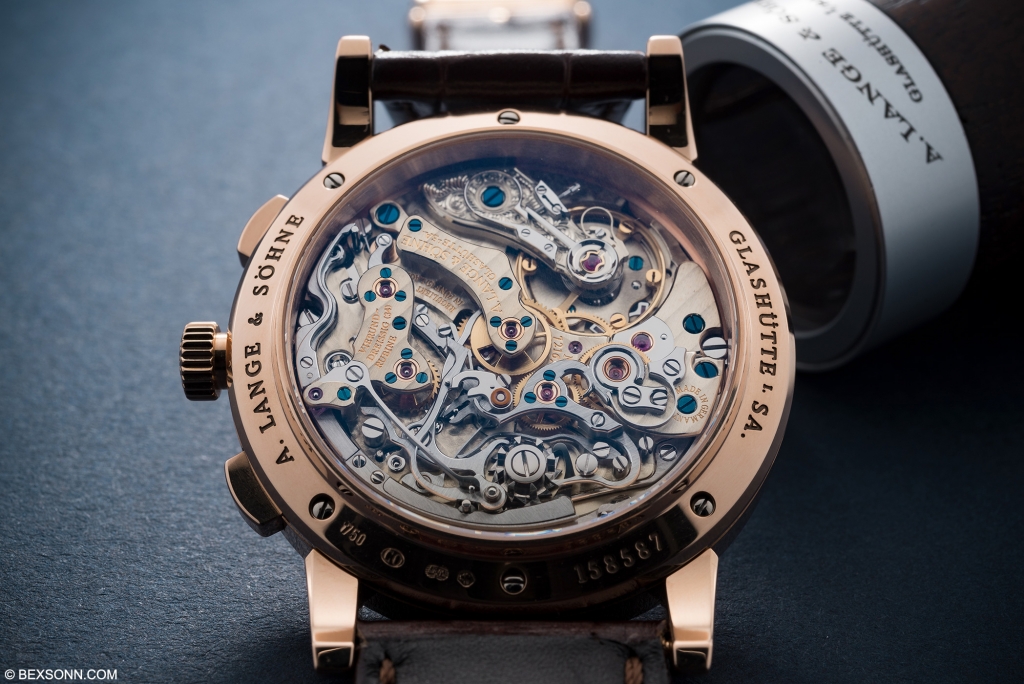 Turning a Lange 1815 chronograph over to view the movement through the sapphire-crystal caseback reveals one of the technically most exquisite and at the same time most beautiful chronograph mechanisms ever made. The most astounding thing about this manual-wound calibre L951.5 movement has to be its depth. I’ve said it before and I’ll say it again, gazing into a Lange chronograph movement can only be likened to mechanical architectural works of art. Crafted to the highest Lange quality standards, decorated and assembled by hand, without doubt, the L951.5 is a sight to behold.
Turning a Lange 1815 chronograph over to view the movement through the sapphire-crystal caseback reveals one of the technically most exquisite and at the same time most beautiful chronograph mechanisms ever made. The most astounding thing about this manual-wound calibre L951.5 movement has to be its depth. I’ve said it before and I’ll say it again, gazing into a Lange chronograph movement can only be likened to mechanical architectural works of art. Crafted to the highest Lange quality standards, decorated and assembled by hand, without doubt, the L951.5 is a sight to behold.
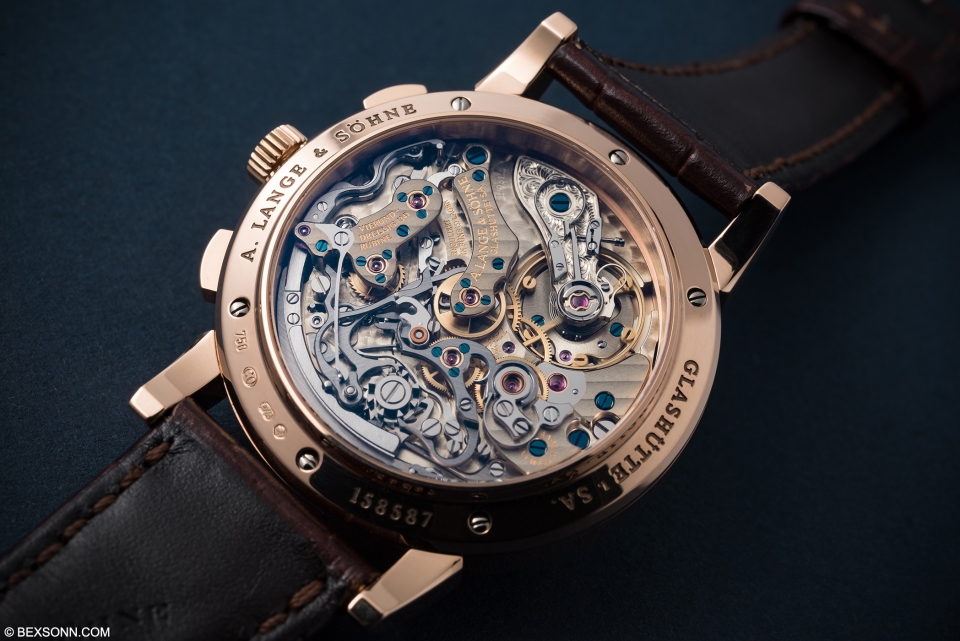 The calibre L951.5 chronograph movement makes use of a column-wheel control and a stepped pinion for the precisely jumping minute counter. Of course one of the highlights of this gorgeous movement is the flyback function, a device found only in very few chronographs but what exactly is it for? This function was mainly used to measure time consecutively, without the need of having to stop the chronograph before using it again. Pilots mainly used timepieces like these, as it saved time and was much easier to operate to instantly restart the chronograph via one push, instead of three. With one single push piece, the 1815 chronograph can be stopped and reset in the middle of a time measurement.
The calibre L951.5 chronograph movement makes use of a column-wheel control and a stepped pinion for the precisely jumping minute counter. Of course one of the highlights of this gorgeous movement is the flyback function, a device found only in very few chronographs but what exactly is it for? This function was mainly used to measure time consecutively, without the need of having to stop the chronograph before using it again. Pilots mainly used timepieces like these, as it saved time and was much easier to operate to instantly restart the chronograph via one push, instead of three. With one single push piece, the 1815 chronograph can be stopped and reset in the middle of a time measurement.
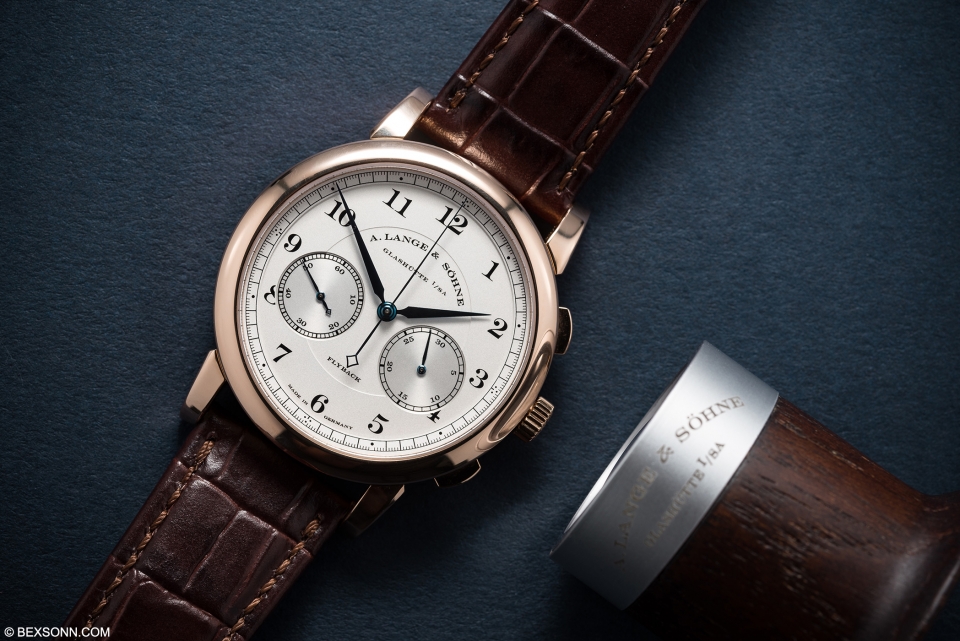 In my opinion, the 39.5 mm is what makes this Lange pretty much perfect, it’s no fuss yet simple and functional design is a standout feature. Made in pink or white-gold, all angles and curves have been polished to a mirror shine. One thing I’ve always loved about Lange’s timepieces are the way the lugs meet the case and it is no different in this case; it is amazing how small details like this make all the difference to the overall look and feel of a timepiece.
In my opinion, the 39.5 mm is what makes this Lange pretty much perfect, it’s no fuss yet simple and functional design is a standout feature. Made in pink or white-gold, all angles and curves have been polished to a mirror shine. One thing I’ve always loved about Lange’s timepieces are the way the lugs meet the case and it is no different in this case; it is amazing how small details like this make all the difference to the overall look and feel of a timepiece.
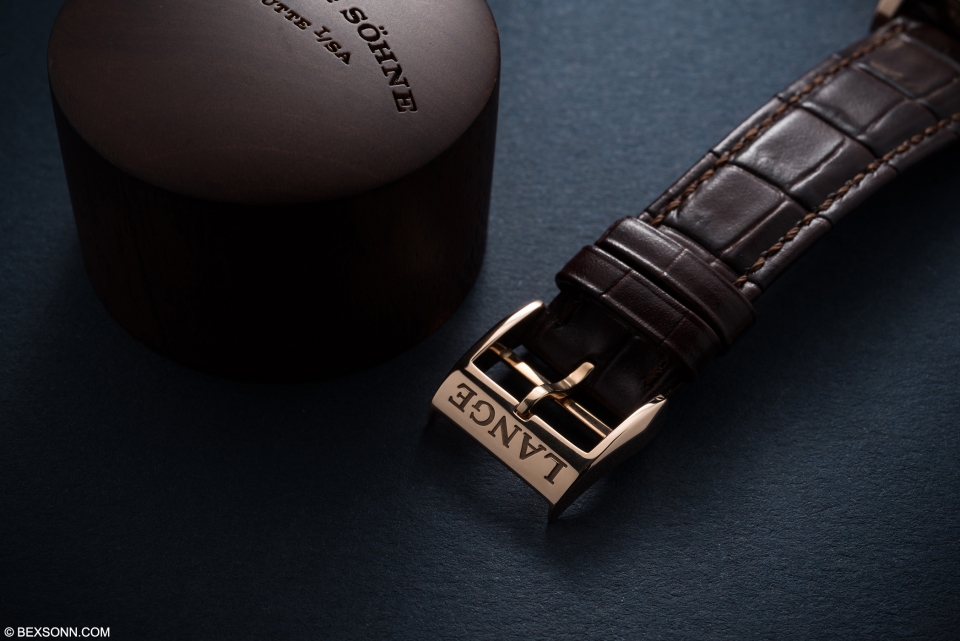 Like all of Lange’s timepieces the 1815 Flyback makes use of rectangular push pieces, at 2 and 4 o’clock on the case band. The case features a large fluted crown that is the perfect size and has a gratifying feel about it, which is practical when considered it will get used quite often. Covering the dial is anti-reflective sapphire crystal and the same is used on the exhibition case back. The case is secured to the wrist by a hand-stitched crocodile strap with solid pink or white-gold Lange prong buckle.
Like all of Lange’s timepieces the 1815 Flyback makes use of rectangular push pieces, at 2 and 4 o’clock on the case band. The case features a large fluted crown that is the perfect size and has a gratifying feel about it, which is practical when considered it will get used quite often. Covering the dial is anti-reflective sapphire crystal and the same is used on the exhibition case back. The case is secured to the wrist by a hand-stitched crocodile strap with solid pink or white-gold Lange prong buckle.
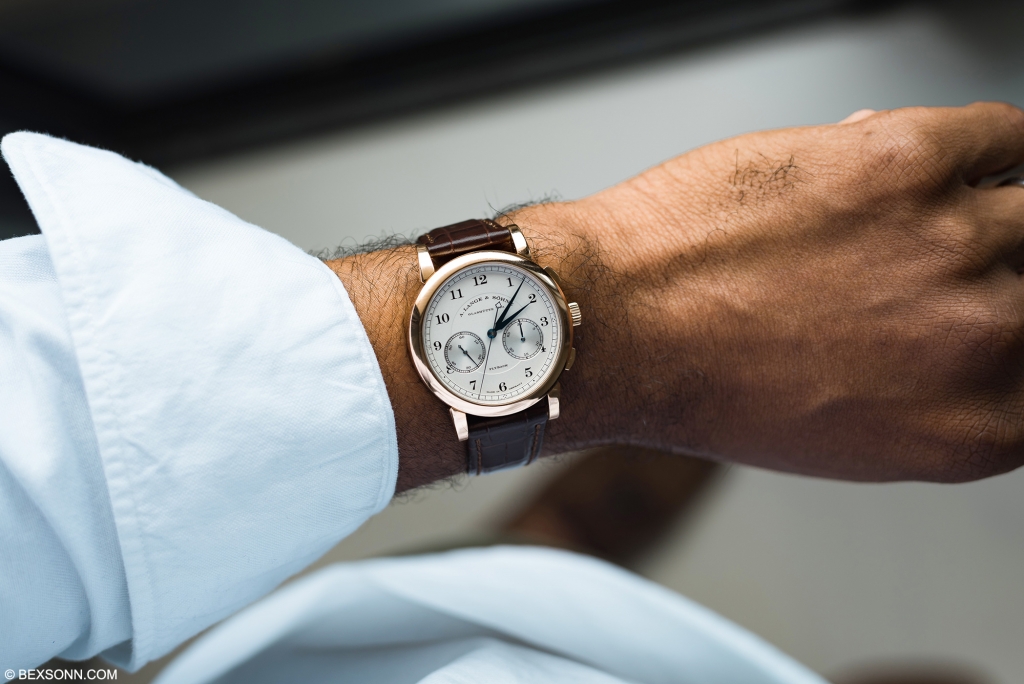 Now, what I find perhaps more intriguing is that if you would have asked me two years ago what is my grail timepiece, the answer would’ve always been the same, “Lange Datograph.” But after living with this 1815 chronograph, I think you’ll find my retort would be somewhat different now. As with time, your taste changes and become more refined but who’s not to say it wouldn’t change again? However, I think right now, at this moment in time, the 1815 Flyback Chronograph has superseded the Datograph that I’ve always held so dear.
Now, what I find perhaps more intriguing is that if you would have asked me two years ago what is my grail timepiece, the answer would’ve always been the same, “Lange Datograph.” But after living with this 1815 chronograph, I think you’ll find my retort would be somewhat different now. As with time, your taste changes and become more refined but who’s not to say it wouldn’t change again? However, I think right now, at this moment in time, the 1815 Flyback Chronograph has superseded the Datograph that I’ve always held so dear.
There is just so much to love about it; as I’ve already mentioned it is a much sleeker package in comparison to the Datograph. Okay, it doesn’t have the Lange signature outsized date window but that affords a much cleaner and more classic dial. And though some may be put off by the sub dials that sit below the centre axis of the dial, I actually kind of like it, not to mention the full use of Arabic numerals. On the wrist it is pure comfort, at no point while wearing the 1815 Flyback did it feel uncomfortable, which isn’t something that could be said for DS Flyback, in fact at times I forgot I was even wearing it.
However, if there is one thing that I must add, is that I admittedly prefer the older version of the 1815 Flyback, simply because of the pulsation scale – sounds trivial but that’s just me. While the newer version does have better legibility and a more classical aesthetics, there is just something more seductive about the original version. But I would settle for the boutique edition 1815 Flyback that actually comes with a pulsation scale. That said, one thing is for sure, the 1815 Flyback Chronograph is a connoisseurs’ chronograph timepiece that has German precision engineering written all over it.
The 1815 Flyback Chronograph, is only available in pink or white-gold and comes on a brown or black leather crocodile strap. Both are priced at £40,300, which in comparison to similar chronographs from Patek & Vacheron, is rather impressive. To add, a Boutique Edition 1815 Flyback will set you back €40,900.
For more information on the 1815 Flyback Chronograph, visit the official A.Lange & Söhne website.
